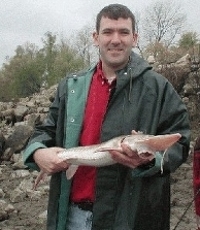James E. Garvey
Professor

Many investigators have assumed that the bioenergetics of ectotherms respond similarly to conditions along environmental gradients. My colleagues and I have been challenging this view, finding that energetic adaptations can influence growth and behavior of fish along broad latitudinal gradients. Current research is exploring how adaptations influence biotic interactions in young fish, ultimately affecting their recruitment to older life stages.
I also am interested in understanding how fish life histories respond to natural variation in ecosystem characteristics and human-induced perturbations such as exploitation and habitat alteration. Changes in life histories (e.g., schedules of maturation, growth rates, timing of reproduction) will greatly affect population structure and dynamics. My students and I are exploring these complex issues in a variety of systems including sturgeon populations in the Upper Mississippi River and catfish assemblages in the Wabash River.
The movement of fish in aquatic ecosystems is driven by both abiotic (e.g., temperature, oxygen, flow) and biotic (e.g., competition, predator avoidance, food availability) factors. Presumably, fish move to find habitats that are closest to their "optimal" physiological and reproductive requirements. In rivers, fish may move into backwater or tributary habitats to reproduce or to evade adverse conditions in the main channel, such as cold temperatures and high flow. A current group of students is exploring the relative importance of riverine versus tributary habitats in Smithland Pool of the Ohio River, and relating this to seasonal changes in abiotic conditions. Our hope is that this research will be used to provide guidance for habitat improvement projects. Because navigation by barges may alter flow regimes at main channel habitats and influence habitat for fish, this research may lend insight into the potential effects of navigation on resident fish assemblages.
Education
Ph.D.,Ohio State University
Courses taught
Conservation Biology (ZOOL 410), Fish Stock Assessment (ZOOL 468)
Areas of interest
Fish Ecology, Fish Management, Food Web Dynamics, Bioenergetics
Selected Recent Publications
Csoboth LA, Garvey JE. 2008. Lateral exchange of larval fish between a restored backwater and a large river in the east-central USA. TRANSACTIONS OF THE AMERICAN FISHERIES SOCIETY 137: 33-44
Degrandchamp KL, Garvey JE, Colombo RE. 2008. Movement and habitat selection by invasive Asian carps in a large river. TRANSACTIONS OF THE AMERICAN FISHERIES SOCIETY 137: 45-56
Garvey JE, Whiles MR, Streicher D. 2007. A hierarchical model for oxygen dynamics in streams. CANADIAN JOURNAL OF FISHERIES AND AQUATIC SCIENCES 64: 1816-1827.
DeGrandchamp KL, Garvey JE, Csoboth LA. 2007. Linking adult reproduction and larval density of invasive carp in a large river. TRANSACTIONS OF THE AMERICAN FISHERIES SOCIETY 136: 1327-1334.
Colombo RE, Garvey JE, Wills PSA guide to the embryonic development of the shovelnose sturgeon (Scaphirhynchus platorynchus), reared at a constant temperature. JOURNAL OF APPLIED ICHTHYOLOGY 23: 402-410.
Colombo RE, Garvey JE, Wills PS. 2007. Gonadal development and sex-specific demographics of the shovelnose sturgeon in the Middle Mississippi River. JOURNAL OF APPLIED ICHTHYOLOGY 23: 420-427.
Colombo RE, Garvey JE, Jackson ND, et al. 2007. Harvest of Mississippi River sturgeon drives abundance and reproductive success: a harbinger of collapse? JOURNAL OF APPLIED ICHTHYOLOGY 23: 444-451.
Schultz DW, Garvey JE, Brooks RC. 2007. Backwater immigration by fishes through a water control structure: Implications for connectivity and restoration. NORTH AMERICAN JOURNAL OF FISHERIES MANAGEMENT 27: 172-180.
Koch BT, Garvey JE, You J, et al.Elevated organochlorines in the brain-hypothalamic-pituitary complex of intersexual shovelnose sturgeon. ENVIRONMENTAL TOXICOLOGY AND CHEMISTRY 25: 1689-1697.
Williamson CJ, Garvey JE. 2005. Growth, fecundity, and diets of newly established silver carp in the middle Mississippi River. TRANSACTIONS OF THE AMERICAN FISHERIES SOCIETY 134: 1423-1430.
Vanni MJ, Arend KK, Bremigan MT, Bunnell DB, Garvey JE, Gonzalez MJ, Renwick WH, Soranno PA, Stein RA. 2005. Linking landscapes and food webs: Effects of omnivorous fish and watersheds on reservoir ecosystems. BIOSCIENCE 55: 155-167.
Garvey JE, Ostrand KG, Wahl DH. 2004. Energetics, predation, and ration affect size-dependent growth and mortality of fish during winter. ECOLOGY 85: 2860-2871.
Garvey JE, Rettig JE, Stein RA, Lodge DM, Klosiewski SP. 2003. Scale-dependent associations among fish predation, littoral habitat, and distributions of crayfish species. ECOLOGY 84: 3339-3348.
Garvey JE, Marschall EA. 2003. Understanding latitudinal trends in fish body size through models of optimal seasonal energy allocation. CANADIAN JOURNAL OF FISHERIES AND AQUATIC SCIENCES 60: 938-948.
Micucci SM, Garvey JE, Wright RA, et al. 2003. Individual growth and foraging responses of age-0 largemouth bass to mixed prey assemblages during winter. ENVIRONMENTAL BIOLOGY OF FISHES 67: 157-168.
Garvey JE, Devries DR, Wright RA, et al. 2003. Energetic adaptations along a broad latitudinal gradient: Implications for widely distributed assemblages. BIOSCIENCE 53: 141-150.
For more information on my research program, please see my lab webpage.
